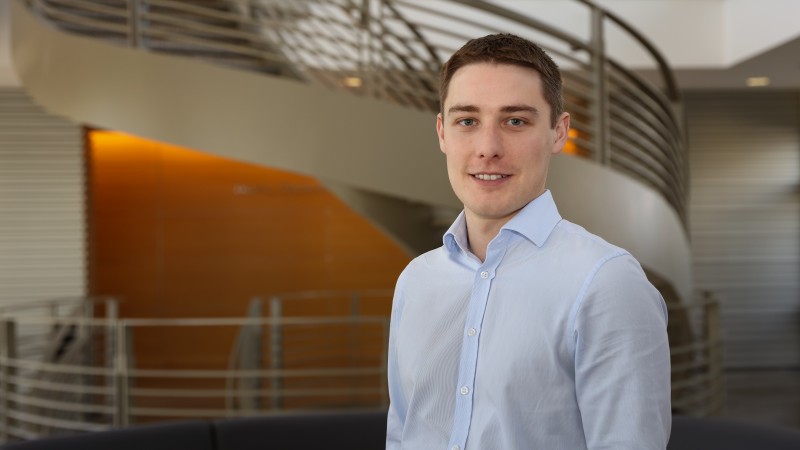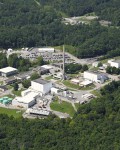Scientists and engineers are always searching for ways to solve the world’s biggest challenges, such as reducing carbon emissions, creating more effective cancer treatments, and increasing energy efficiency in electronics.
Early career scientist Matthew R. Ryder, a Clifford G. Shull Fellow at the Department of Energy’s (DOE’s) Oak Ridge National Laboratory (ORNL), is using neutron science to research how next-generation porous materials known as metal-organic frameworks (MOFs) and covalent-organic frameworks (COFs) could be used to meet those challenges. To aid in designing materials for the future, Ryder’s research aims to understand how the molecular structures of materials can affect response properties such as mechanical and thermal stability.
MOFs and COFs have record-breaking levels of porosity and internal surface areas that allow them to selectively capture and store large quantities of molecules such as gases or medicines. These properties, Ryder explains, make them highly attractive to researchers interested in energy storage, CO2 sequestration, and drug delivery. However, he says, because of the nature of the porous structure, these materials are often unstable and can break down very quickly.
“Porous framework materials such as MOFs and COFs offer a promising solution to a diverse range of smart applications,” he said. “However, despite being proposed for numerous promising applications, only a few are being used commercially, in part due to instabilities under real-life conditions.”
Ryder is focused on solving this problem. In the past, his research has involved analyzing the vibrational motions and electrical responses of MOFs and correlating them to structural phenomena such as breathing and mechanical stability. As a Shull Fellow at ORNL, Ryder is using quantum mechanics calculations and high-resolution neutron scattering to study how these materials respond to changes in temperature and pressure.
Documenting the different behaviors of these materials using neutrons will help Ryder understand how to make them feasible for real-world applications.
From a young businessman to one of the UK’s most promising scientists
Ryder’s success and interest in science and technology developed when he was very young.
“I remember overclocking my computer’s single-core processor when I was 13,” he said. “Over a decade later, I now use some of the world’s most powerful supercomputers on a daily basis.”
In his early teenage years, Ryder also demonstrated a strong passion for entrepreneurship by developing and running his own online business. By the time he was 16, he had several successful businesses, including a retail store and a golfing facility close to his home in the Shetland Islands in northern Scotland.
Despite his success in business, Ryder chose to study science, an interest that he attributes to his supportive family and a retired high school chemistry teacher who always inspired him to learn new things.
“I always loved science and computing when I was a child. Therefore, it made sense to further my interest and curiosity when I went to university.” Ryder said.
While studying for his undergraduate degree at Heriot-Watt University in Edinburgh, Ryder says, he fell in love with computational chemistry during a summer research project. He credits the teaching and a supportive project supervisor as some of the main reasons for his scientific success.
He received his undergraduate degree in chemistry in 2013 with first-class honors—equivalent to a 4.0 GPA.
“Heriot-Watt University provided me with the perfect foundation for my career, and my undergraduate project supervisor professor, Maciej Gutowski, was the one who ultimately convinced me that scientific research was for me,” Ryder said.
Next, he attended the University of Oxford and received his PhD—or D.Phil. in Oxford terms—in engineering science in 2018. While at Oxford, Ryder was also a part-time physics lecturer at two of Oxford’s most prestigious colleges, Balliol and Pembroke college. Balliol is Oxford’s oldest college, founded in 1263—over 750 years ago.
Ryder has already been recognized as an accomplished young scientist with awards, honors, and recognitions. Nobel Laureate Sir Fraser Stoddart called Ryder a “rising star in the world of science.”
In 2017, the British Zeolite Association recognized Ryder with its Founders’ Award as “One of the UK’s best and most promising postgraduate scientists.” Ryder was also a Doctoral Prize Fellow with the UK’s Engineering and Physical Sciences Research Council and was the youngest person ever to be awarded his current fellowship.
A perfect fit
It was at Oxford that Ryder was introduced to neutron scattering, at the nearby Rutherford Appleton Laboratory’s ISIS Neutron and Muon Source. Pursuing the potential of neutron scattering, Ryder received a scholarship from the Science and Technology Facilities Council at the Centre for Molecular Structure and Dynamics, as well as several others that enabled him to conduct neutron experiments.
After visiting ORNL to give an invited seminar in 2017, Ryder was recruited to join the laboratory and was the youngest person ever to be offered the Clifford G. Shull Fellowship, which is awarded to promising scientists who are using neutron scattering in their research.
The fellowship’s namesake, Clifford G. Shull, was a pioneer in the field of neutron scattering in the 1940s at ORNL and was later presented with the Nobel Prize in Physics for his work.
ORNL has two of the world’s most powerful neutron sources—the Spallation Neutron Source (SNS) and the High Flux Isotope Reactor (HFIR)—as well as two of the world’s most powerful supercomputers—Summit at number one and Titan at number nine.
“The offer from ORNL was very attractive—the most powerful spallation and reactor neutron sources coupled with two of the most powerful supercomputers in the world,” Ryder said. “It was the perfect opportunity for me.”
Using neutron scattering techniques at SNS and HFIR, Ryder can analyze materials at the molecular level and understand their properties and atomic structure in different conditions. With high performance computing, he can run complex quantum mechanics calculations to allow him to explain the experimental discoveries and further the advancement of next-generation materials science.
“One of the primary goals of my research is to better understand how these materials function at the molecular level,” Ryder said. “Advancing our knowledge in this area is critical for addressing many of the limitations in the field of energy, environmental, and nuclear materials.”
Now, a few months into his ORNL career, he’s enjoying the change of pace from the university environment.
“One of the best things about ORNL is how easy it is to communicate with people from different disciplines and collaborate internally,” Ryder said. “In the first few months, I’ve been able to establish exciting scientific collaborations both internally and externally and have been invited to present my work in three different continents.
“I am confident that with the world-leading neutron scattering and supercomputing facilities and the outstanding support from my colleagues in the Neutron Sciences Directorate, we can advance the current understanding of porous materials and gain an insight into counteracting their instabilities or even using them for our benefit.”
ORNL is managed by UT-Battelle, LLC for DOE’s Office of Science, the single largest supporter of basic research in the physical sciences in the United States. DOE’s Office of Science is working to address some of the most pressing challenges of our time. For more information, please visit http://science.energy.gov.—by Josh Witt





